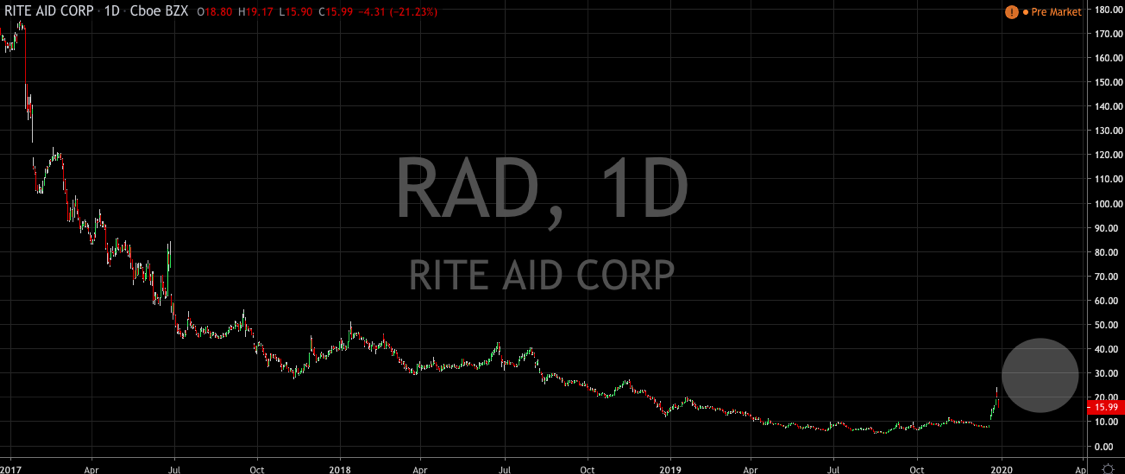Shares of Rite Aid (NYSE: RAD) have been giving investors heart attacks of pleasure and of fear in the past couple of trading sessions as they’ve made double-digit percentage jumps up and down.
The volatility started on December 19th when the company released its Q3 earnings report. At $0.54, non-GAAP EPS registered a massive beat on analyst expectations of $0.15 while revenue also came in on top of the consensus.
Having taken more than a 50% beating in 2019 and more than 80% since the start of 2018, Wall Street was quick to jump on the massive surprise to the upside and shares gapped up 30% at the open. The buying continued throughout the day and through most of the following week. At their high point on Friday, they were a full 190% higher than where they closed the day before the earnings release. By this point, RSI was touching 90 and it was clear the buying frenzy couldn’t continue. After all, this is still a stock that’s down 90% over the past 3 years.
There was some profit-taking into Friday’s close and this continued during Monday’s session. As we head into the final trading session of 2019, the stock is down 30% from its recent high but still up almost 100% from before the earnings release.
How Short Squeezes Happen
As one of the most heavily shorted stocks on the market, the short-sellers who are still alive after the last fortnight will be breathing a little easier after the pullback from the last two sessions. According to Refinitiv, almost 30% of the company’s outstanding shares have been shorted, making the stock very vulnerable to short squeezes when there are upside surprises.
When a stock is heavily shorted it means that bearish investors are essentially betting a stock’s value will decrease. They have sold the stock as the first step in the trade and plan to buy it back at a lower price, thus capturing the difference as profit. It’s the exact opposite of the more traditional long trade, where you look to buy low and then sell high. While the trades seem to be clean vice-versas of each other, they differ in the risk profile. When you buy a stock to ‘get long’, the most you can lose is 100% of your capital and that’s only if the stock’s value decreases to $0.00. When you’re short, you’re maximum loss is in theory unlimited, just as the highest price that a stock can rise up to is unlimited. Kinda scary right?
Short squeezes happen when a beaten-down stock suddenly, for various reasons such as a surprisingly good earnings report, for example, turns around and starts rallying hard to the upside. As the trade blows up in the face of short-sellers, they’re forced to buy back the shares to simply close out their position in the face of mounting losses and margin calls etc. Alongside the bulls who are suddenly getting involved, the fresh and continued buying from the shorts themselves add to the upward momentum which only increases the pressure on those still short.
What Happens Now?
Many on Wall Street will remember the famous short squeezes of Volkswagen’s stock in 2008 and DryShips in 2016. It remains to be seen whether the bulls can really set the cat among the pigeons but the next few trading sessions will tell us one way or the other. If there’s even a sniff of a short squeeze, the big funds and players are always tempted to get involved but if the bulls are going to go for it now with Rite Aid, they need to do it fast before the market loses interest and the bears take charge once again.
For those looking to get involved with a short squeeze, it could be worth waiting for the stock to break above Friday’s high of $23.88 before getting long. This would lend weight to the bulls ability to send the stock soaring while an ability to get back up there and above in the next couple of sessions would suggest they’ve missed their chance and the stock is in for a disappointing trickle back down to earth.

Before you make your next trade, you'll want to hear this.
MarketBeat keeps track of Wall Street's top-rated and best performing research analysts and the stocks they recommend to their clients on a daily basis.
Our team has identified the five stocks that top analysts are quietly whispering to their clients to buy now before the broader market catches on... and none of the big name stocks were on the list.
They believe these five stocks are the five best companies for investors to buy now...
See The Five Stocks Here
Looking to profit from the electric vehicle mega-trend? Enter your email address and we'll send you our list of which EV stocks show the most long-term potential.
Get This Free Report
Like this article? Share it with a colleague.
Link copied to clipboard.